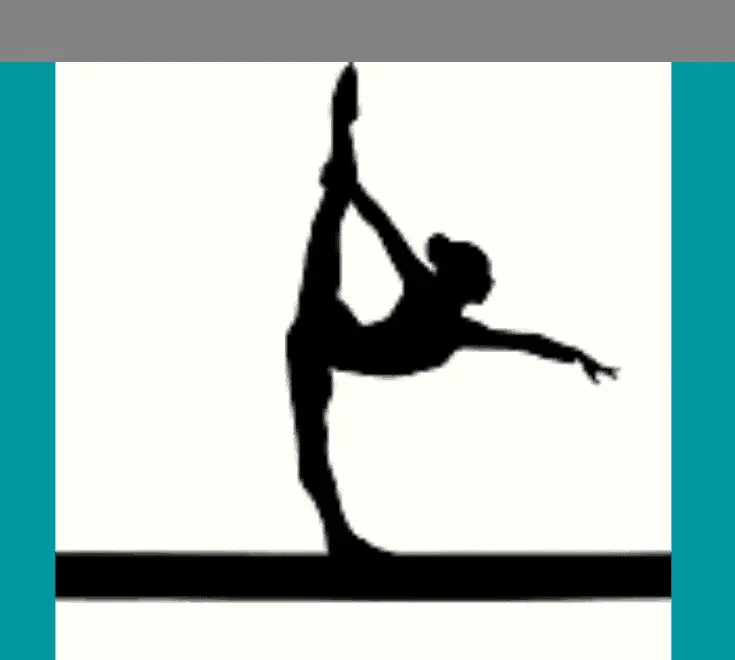This article has been updated to reflect the changes in the 2022-26 Xcel Code of Points.
Xcel beam routines – what are the judges looking for? Well, it’s a bit different at each division, but there are definitely some common themes. The best beam routines display confidence, good form, and good body posture. This is true at all divisions of Xcel beam, whether it’s the first Bronze meet of the year, or the Diamond State Championships.
If you’ve read the vault and bars articles, you know that judging Xcel gymnastics was really tough for me at first. I’ve studied a lot, gone to clinics, reviewed with other judges, and practice judged routines in order to improve my skills at judging all of the Xcel divisions. This past season I judged a LOT of beam, and I’m excited to share what I learned.
Today I’ll show you the requirements and difficulty restrictions for each division, along with some advice to score your best on any routine.
What to Know about Xcel Beam
Each division has 4 Special Requirements on beam. These requirements are consistent across the divisions, with the difficulty increasing progressively. The Special Requirements consist of a turn, a dance element (or two), an acro element (or two), and a dismount.
Special Requirements can be fulfilled by using any skill from that Division’s skill chart, or any skill from the Xcel Code of Points (COP) that meets the restrictions of the Division. Handstands are not required to be held in any division of Xcel.
Turns are expected to be performed on toe. Once the heel drops, the turn is considered complete. If the turn is missing 90° or more, its value drops to the lower valued skill. Example: full turn is missing 90° of the turn; the gymnast gets credit for a 1/2 turn.
The beam routine should flow together, with good rhythm. The gymnast should display confidence while she is on the beam. Steps should be on toe, and the gymnast should maintain good posture throughout the routine.

Rules Related to Series Connection
A series is a connection of two or more skills in a row. A gymnast could perform an acro series, a dance series, or a mixed series. All series are expected to be directly connected without stops, pauses, or extra steps. There is an up to 0.20 deduction for a slow connection, and there are also several instances in which the connection is considered broken. A broken connection means that the gymnast will NOT receive Special Requirement credit.
ALL series are considered broken if:
- The gymnast’s body completely stops moving between skills
- A balance error occurs between skills
- The gymnast repositions her support leg
- An extra step, hop, jump, or foot movement occurs between skills
- The gymnast lands with knees bent, completely straightens them, then bends them again to take off for the second element in the series
- The free leg kicks above 45° between skills (example: cartwheel, roundoff series)
- There is any deviation of body movement that is NOT in line with the beam
A backward acro flight series, or forward/sideward to backward acro flight series is considered broken if the series moves slowly between elements, or if the gymnast appears cautious during the connection. These series must move quickly from skill to skill, with no hesitation, to receive connection credit.
For more information on series connections, with videos, check out this article about beam series.
Beam Rules Specific to Xcel
- All acro skills must start and finish on the beam.
- Handstands are all considered the same skills, regardless of the angle achieved. This means that 3/4 handstand and vertical handstand hold are the same skill.
- Handstands are considered vertical if they are within 10° of vertical. A handstand that is between 1°-10° from vertical will receive a 0.10 amplitude deduction, in addition to execution deductions.
- Value Part (VP) and Special Requirement (SR) credit for leaps and jumps will be awarded if they are within 20° of the required split angle. The up to 0.20 deduction for insufficient split applies if the split is less than the required angle.
- Restricted elements do NOT receive VP or SR credit, and a 0.50 deduction will be taken off the SV.
Xcel Beam: Bronze Division

Value Parts
Bronze gymnasts must perform 4 “A” skills (worth 0.10 each off the Start Value).
Special Requirements
- Min. 1/2 turn on 1 or 2 feet
- One jump or leap (not mount or dismount)
- One acro element (non-flight)
- Dismount (no saltos or aerials)
Difficulty Restrictions
- No “B” or higher skills
- No salto or aerial dismounts
- No walkovers
A split jump or straddle jump in cross position (normally B’s) will both receive “A” credit, regardless of the angle of the split. Split leaps (normally B’s) will also receive “A” credit with any split angle.
Considerations for Bronze Beam
Acro Considerations
Bronze gymnasts can receive Value Part credit, and acro Special Requirement credit, for a lever. To receive credit for the lever, one leg must be off the beam. There is no requirement for height of the free leg. The hands must touch the beam while the free leg is off the beam. There is no deduction for a bent support leg. The ideal body position is a straight line from fingers to toes, and body position deductions CAN be applied if the gymnast does not show a straight body position.
A handstand is another allowable skill in the Bronze division. A partial handstand is acceptable in this division. For Bronze gymnasts, the legs do not have to touch while they are off the beam, and only one leg needs to reach 45°.
There are many more options for skills that fulfill the acro Special Requirement, but those are the ones that people usually ask about!
General Considerations
Just like on the other events, Bronze beam routines do not require many skills. It is in the gymnast’s best interest to complete the requirements using as few skills as possible, and using the skills she can complete with the least amount of deductions. There is no undertime deduction, so it’s fine to do those four skills and get off the beam!
Clean execution is very important in the Bronze division. Most scores will be high, simply because there aren’t very many skills in the routine. To really set your routine apart, make sure it is performed with great form. General deductions such as rhythm and footwork can separate the good from the great in this division as well.
Xcel Beam: Silver Division
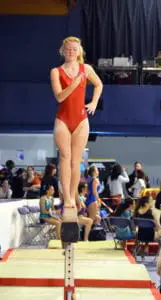
Value Parts
Silver gymnasts must perform 5 “A” (or more difficult) skills (worth 0.10 each off the Start Value).
Special Requirements
- Min. 1/2 turn on 1 foot
- One jump or leap with 90° cross or side split (not mount or dismount)
- One acro element (non-flight)
- Dismount
Difficulty Restrictions
- No “B” acro skills. “B” dance skills ARE allowed.
- No “C” or higher VP
Considerations for Silver Beam
Silver is the first division that has a split angle requirement for the leap/jump. This leap or jump can display a forward split or a straddle split. A split leap would fulfill the requirement, and so would a split or straddle jump. It can be fun to play around with a few different leaps and jumps to see which one the gymnast can perform the best. Remember that Special Requirement credit will be given if the leap/jump is within 20° of the required angle. In this case, a 70° split angle would fulfill the requirement, but it would incur an up to 0.20 deduction for insufficient split.
Another difference between Silver and Bronze is that in Silver, the gymnast must perform her 1/2 turn on one foot. A pivot turn is no longer allowed to count for the turn Special Requirement.
Finally, Silver gymnasts must touch their feet together at 45° to get Value Part credit for their handstand.
Xcel Beam: Gold Division
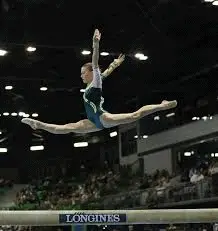
Value Parts
Gold gymnasts must perform 6 “A” (or more difficult) skills (worth 0.10 each off the Start Value).
Special Requirements
- Min. 1/1 turn on 1 foot
- Two DIFFERENT Group 2 skills (OR jumps/leaps from Gold chart). ONE with at least 120° cross or side split (not mount or dismount)
- Two acro elements with or without flight. One must achieve or pass through vertical.
- Dismount
Difficulty Restrictions
No “C” or higher skills.
Considerations for Gold Beam
Vertical Skills
In Gold beam, there are always questions about the vertical acro element. Vertical, as defined in the Xcel COP, means that the gymnast’s hips need to be over her shoulders, “as in a handstand or headstand”. No hold is required. If the gymnast performs a partial handstand, in which she does not reach vertical, this would not count as her vertical element. In order for a handstand to count as a vertical element, the body must achieve a vertical position (within 10°), with the hips over the shoulders. The legs do not have to come together.
If the gymnast achieves vertical during her mount (i.e. press handstand), it will count as her vertical acro skill. A gymnast can also use a roll to complete this requirement, as long as the hips open to achieve a vertical position over the shoulders. A roll with a closed hip angle will NOT fulfill this requirement. A candlestick also will NOT fulfill the requirement, because the support is on the upper back and shoulders.
Other Gold beam questions
Another question I get about the acro skills is whether they have to be different. The two acro skills can be the same, but in order for both of them to get Value Part credit, they must be performed in a different connection. For example: Gymnast performs two isolated cartwheels. She only gets credit for the first one, and loses the acro Special Requirement. If she had performed a cat leap connected to one of the cartwheels, or a straight jump out of one, she would get Value Part credit for both cartwheels, and the Special Requirement is met.
If the gymnast performs a handstand, then a cartwheel to handstand, those skills are considered the SAME, because they are in the same box in the Xcel COP. The gymnast would need to perform a different connection into or out of one of the handstands in order for them to count as two separate Value Parts.
The required leaps/jumps can be in a series, or they can be isolated. The split requirement is 120° for one of the two skills, and a leap/jump that goes to at least 100° will get credit with a split deduction. The two leaps/jumps must be DIFFERENT, unlike the acro skills.
Xcel Beam: Platinum Division
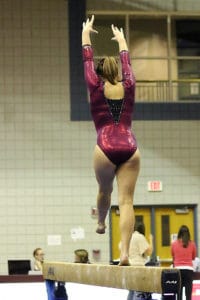
Value Parts
Platinum gymnasts must perform at least 6 “A” skills (worth 0.10 each off the Start Value) and 1 “B” skill (worth 0.30 off the Start Value).
Special Requirements
- Min. 1/1 turn on 1 foot
- Dance Series: Two Group 1, 2, or 3 skills (same or different), AND one leap/jump with at least 120° cross or side split (can be isolated or in series)
- One acro flight element OR Acro series (with or without flight)
- Dismount
Difficulty Restrictions
- No “C” Acro skills
- No “D” or higher skills
Considerations for Platinum Beam
When deciding whether to use a flight skill or an acro series for the acro SR, consider the type of series, and the gymnast’s ability to connect that series. It’s usually less risky to perform the acro flight skill than a non-flight series, because of the possibility of breaking the series. If the goal is to get the gymnast used to competing an acro series, using a flight element in the acro series is a good way to work on the series AND still make sure the Special Requirement is met.
Xcel Beam: Diamond Division
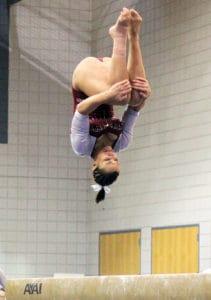
Value Parts
Diamond gymnasts must perform at least 5 “A” skills (worth 0.10 each off the Start Value) and 2 “B” skills (worth 0.30 off the Start Value).
Special Requirements
- Min. 1/1 turn on 1 foot
- Dance Series: Two Group 1, 2, or 3 skills (same or different), AND one with at least 155° cross or side split (can be isolated or in series)
- Acro series (with or without flight) AND One acro flight element (isolated or in series)
- Dismount – Salto or Aerial
Difficulty Restrictions
- Maximum of 1 “D” skill allowed
- No “E” skills
Considerations for Diamond Beam
Diamond beam reminds me of Level 7 beam, with the acro requirement of an acro series and a flight element. The flight element can be included in the series, or performed as an isolated element. Consider what type of series is the easiest for the gymnast to perform well, and remember that the more skills in the routine, the more chances for deductions and large errors.
At the Diamond division, I will typically see a wide range of skills and abilities. There are no deductions for composition, meaning that a gymnast who performs a back handspring-layout series has no advantage over a gymnast who performs a cartwheel-roundoff series. Judges can, however, use general deductions to separate gymnasts. For instance, judges can deduct for artistry, dynamics, rhythm, and overall body posture.
Want to Learn More?
Here are a few more articles to read if you’re interested in learning more about Xcel gymnastics, or beam in general:
What You Need to Know About Xcel Vault
Xcel Bars: Bronze, Silver, and Gold
Xcel Bars: Platinum and Diamond
How to Score Big on Xcel Floor
Is This Beam Series Connected?
References: USA Gymnastics Xcel Code of Points, 2022-2026.
